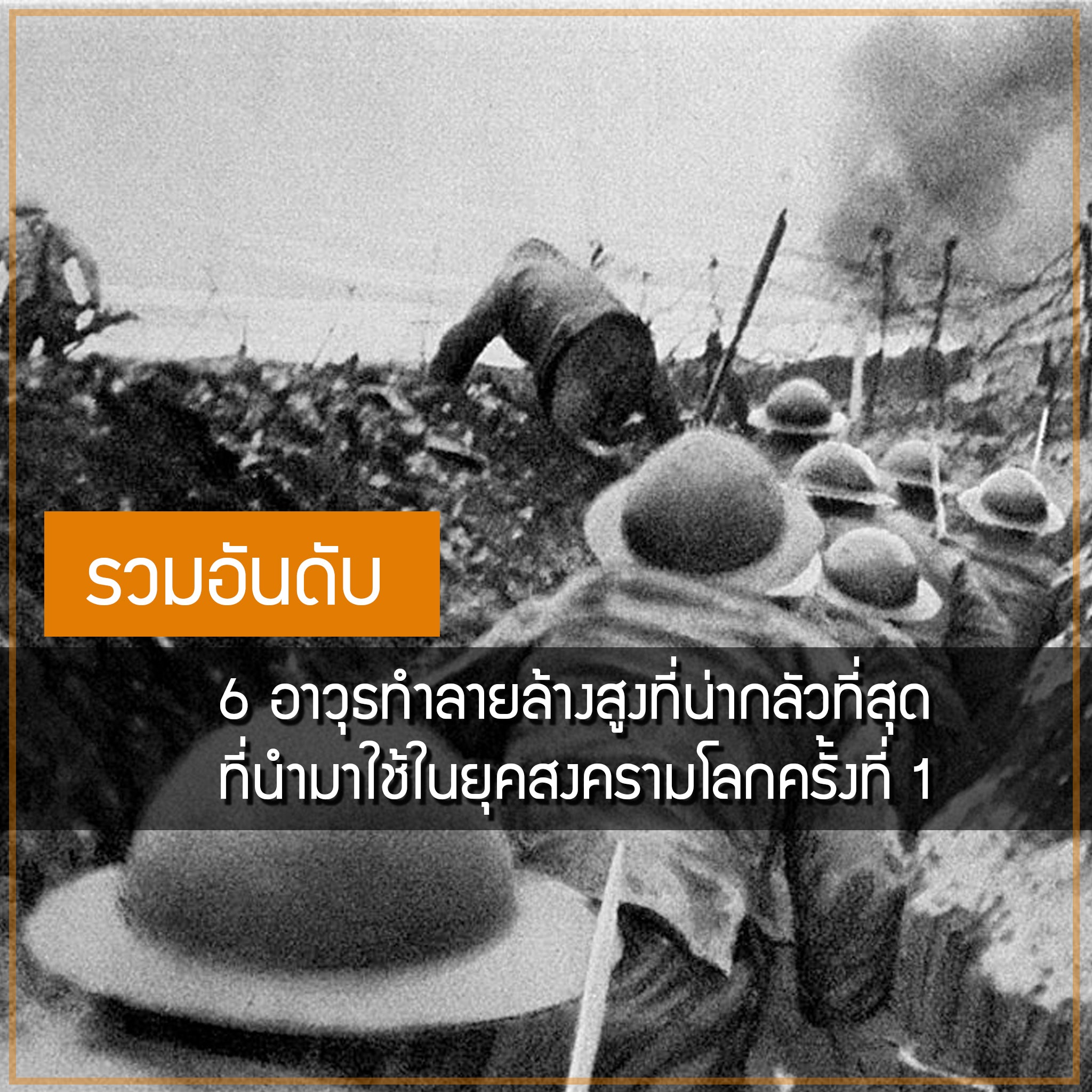World War I began in 1914.
The armies of both sides have also introduced new technologies.
That the world has never seen used in war.
Particles of destruction and terror that arise
Because these new weapons are so scary that some
In places where these new weapons are being used, people are still unable to
Able to live there until now

1. Flamethrower
The idea of burning the enemy to ashes
It is an idea that exists in the minds of those who wage war.
Throughout the history of mankind
However, it had to wait until 1915.
Germany was the first country to produce a flamethrower.
For the first person to succeed
And it was also used in World War I.
Flamethrower is very useful in battle.
And it is a nightmare for the unfortunate victims as well.
Because the second the flamethrower was used, even the soldiers
No matter how strong the bunker or trench is,
They will be burned to death by the flames from the fire gun.
Or if anyone runs away, they will be shot.
By the soldiers waiting outside
The brutal nature of flamethrowers is:
Anyone who carries this weapon is likely to become a target for assassination.
Just as the enemy opposing them noticed the arrival of the flamethrower.
That unfortunate person will immediately become the target of bullets.
And if they are captured, they usually end up being executed.
Due to the cruelty that users have committed
But the British side used the flamethrower in a different way.
From the German side, the United Kingdom developed a flamethrower.
It is called Livens Large Gallery Flame Projector.
It was a stationary flamethrower placed in a long trench line.
It is pointed towards the battle line, with the nozzles protruding from the ground and spraying a wall of flames.
It is 300 feet (274.32 meters) away from the enemy's advance direction.
This British weapon was a great success.
In use in the Battle of the Somme on July 1, 1916.
When this weapon was able to destroy part of the German lines
Allowing British troops to invade and seize the debris
The rest is easily

2. Trench knife
Even though it was an era where people fought with guns,
Close-range hand-to-hand combat is still a common practice in warfare.
However, with World War I
It was a battle using trench warfare, a new type of weapon.
Therefore, it is necessary to use it effectively in close-range combat.
This is the origin of the trench knife.
This terrifying knife was developed by the United States.
Called the M1917 knife, it was the first trench knife.
The United States is a combination of weapons used to kill enemies.
There are 3 types of knives. The handle of this knife is triangular.
This means that this knife can only be used for stabbing.
And it also causes gaping wounds.
The stab wound with the triangular handle of the knife was very brutal.
This led to a ban on the use of this type of weapon under the 1949 Geneva Conventions.
Because it causes terrible suffering to the victim.
The handle of this knife is also a thorny handgrip.
To make the punches in battle more powerful.
And finally, this knife has a "skull crusher" attached to the underside of the handle.
So that users can use it to smash their enemies' skulls.
This knife was further developed into the Mark 1 Trench Knife.
In 1918 but was used in World War II.

3. Trench Raiding Clubs
The trench knife was one of several weapons used by the Allies.
It was developed during the war for use in trench raids.
Sudden
The surprise attack on a trench is a military strategy.
Consisting of moving silently into enemy trenches
Kill anyone in sight, and take back as many prisoners as necessary.
Bomb the enemy's bunkers and quickly withdraw back to the trenches.
of their own side before the enemy realizes that they are in trouble.
Because the use of rifles creates loud noises, assault batons were invented.
Although this assault baton does not have a specific standard design,
But its production also has references to the batons and scepters used in the Middle Ages.
European and also includes anything left over around you that is attached to the baton.
Such as nails, wire fences, or even scrap metal that can be found everywhere to assemble into weapons.
To cause maximum damage

The power of the M1897 Trench gun is fierce.
There were even protests against its use on the battlefield.
4. Shotgun
When American soldiers joined the fight in World War I
On the Western Front, they brought in new weapons.
It was the shotgun that would terrify the German soldiers.
The US military actually used several types of shotguns in the war.
But the most widely used shotgun is the Winchester.
Model M1897 Trench Shotgun
This gun is a modified version of the Winchester Model 1897.
By reducing the barrel length to 20 inches
It has a heat-resistant handle and a bayonet slot.
This shotgun can hold 6 rounds of shotgun shells.
Each round contains .00 (.33 caliber) pellets.
Inside, it is very effective in the trenches.
Until the American soldiers gave it the name
"The Trench Sweeper" or "The Trench Broom"
But the Germans were not happy to face this kind of weapon.
On the battlefield, shotguns are very effective.
So much so that the German side had to protest diplomatically.
In using the shotgun on the battlefield, the Germans argued that the shotgun
It should not be used on the battlefield and should not be threatened with punishment for any American.
Who was arrested while using a shotgun
The United States rejected Germany's demands.
and threatened to exact revenge for any punishment meted out to American soldiers.

Condition of British trenches after poison gas attack
By the Germans (it is thought to be phosgene gas )
In the Battle of Fromel, July 19, 1916
5. Poison Gas
Certainly one of the most fearsome weapons of World War I.
Poisonous gas must be included because poisonous gas is the definition of a brutal weapon.
There were three types of poison gas commonly used in World War I.
They are: 1. Chlorine 2. Phosgene and 3. Mustard.
The first poison gas attack occurred in 1915.
At the Battle of Ispra, it was the Germans who used it to attack French forces.
After that, both sides developed their own chemical gas weapons.
To be used in retaliation in war
The real purpose of using poison gas is not to kill the enemy.
Even if it can be done, it will increase the number of injuries.
A large number of the enemy's belongings or contaminate the enemy's position.
To pressure the enemy to withdraw from the area.
The poisonous gas also caused chaos among the soldiers.
Due to temporary suffocation or blindness
That caused the soldiers to panic and flee from their positions.
But mustard gas is more deadly than other poison gases.
Because the symptoms of those who come into contact with the gas are difficulty breathing.
Or temporarily blind and also burn the skin, causing a large, scary rash.

A barrage of 8-inch cannon fire by the 39th Royal Artillery Regiment.
While firing a cannon in the Fricourt-Mamet valley during the Battle of the Somme in 1916.
6. Artillery
Even though cannons have been used on the battlefield for hundreds of years,
Since before World War I, the damage is incomparable.
If we compare the battles in ancient battlefields with those of the World War era,
That's because ...
- This is the first time that the world's largest cannon has been deployed.
Used in World War I
- Because in the history of warfare, there has never been an encounter like this.
Such a dense artillery barrage
A group of artillery shells fired
Causing such great damage that the soil in the area was torn apart.
Where the battle has turned from one side to the other, it has created potholes.
It was so large that the cannonballs that were fired later
Sometimes it doesn't explode and gets buried in the ground. The artillery shelling
Can easily destroy trenches and entrenched people alive.
Artillery bombardment in World War I was very effective.
Until the term Shell Shock was invented, which is a term used to describe
Symptoms of survivors of artillery bombardment
But there was a sense of panic from the sound and the artillery fire.
And dealing damage using cannons is still considered effective.
So much so that cannons are still used in warfare today.
Source
https://www.wearethemighty.com/articles/the-6-most-terrifying-weapons-of-world-war-i
Written by James Elfick on August 27, 2020
Translated by Thepphong Chaiyarat on September 10, 2020.
Compiled by Ranakrit Sriphumma on September 10, 2020.


